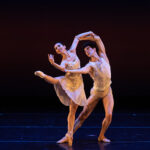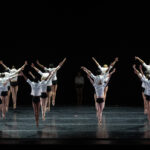Ballet is an art form that has spanned centuries, originating in the 15th and 16th century Italian Renaissance courts. It has since evolved from traditional court dance to an art form that balances athleticism and artistry and supports creative experimentation.
Ballet was introduced into French court life by Catherine de’ Medici during the reign of her husband King Henry II. During this time, ballet looked vastly different to the art form seen today. Dancers wore layers of ornate and brocaded costuming along with large headdresses and formal dress shoes with small heels. This clothing was quite restrictive and only allowed dancers a small range of movement, such as small hops, promenades, slight turns, and of course many curtsies.
Over the next 100 years, during the reign of Louis XIV, ballet as we know it today really started to take shape. Official terminology and vocabulary was gradually codified in French, thanks to Louis XIV’s personal dance master Pierre Beauchamp, who is also credited to creating the 5 main positions of ballet. It was also during this time that ballet went from being primarily court dances to grand spectacles on stage, with elevated platforms, so a greater audience could enjoy as well as elaborate set designs and costumes.
In 1661, Louis XIV established the first ballet academy, known as the Royal Academy of Dance, headed by Pierre Beauchamp. Then in 1669, Beauchamp along with Jean-Baptiste Lully, the director of the Royal Academy of Music, and the famed playwright Moliere, created The Paris Opera Ballet, which still thrives today as the oldest ballet company in the world!
Ballet started to become a more widespread art form and was constantly evolving throughout the centuries. More intricate technique was being introduced, especially for women, as well the development of pointe work. By 1850 Russia had become the leading creative epicenter for ballet. During this time and up through the early 20th century many of the world’s best known ballets, such as The Sleeping Beauty, Swan Lake, Giselle, and The Nutcracker, were created.

In the early 20th century, Serge Diaghilev, a Russian theatre producer, formed a group called the Ballet Russes, which brought together some of the most talented dancers, choreographers, composers, and designers. Touring throughout Europe and America, the Ballet Russes, although no longer together, remains one of the most well known ballet companies in the world. One of its prodigies, George Balanchine saw the popularity of ballet in America during the 1930’s and left Ballet Russes to settle in the United States. Known today as the Father of American Ballet, Balanchine established the world renowned company the New York City Ballet, along with his own style of ballet known as the Balanchine Style, which is taught in schools around the world to this day.
With well established academies and companies across the world, ballet continues to be an ever evolving art form whose history has stood the test of time, and we are excited to see it’s future!







